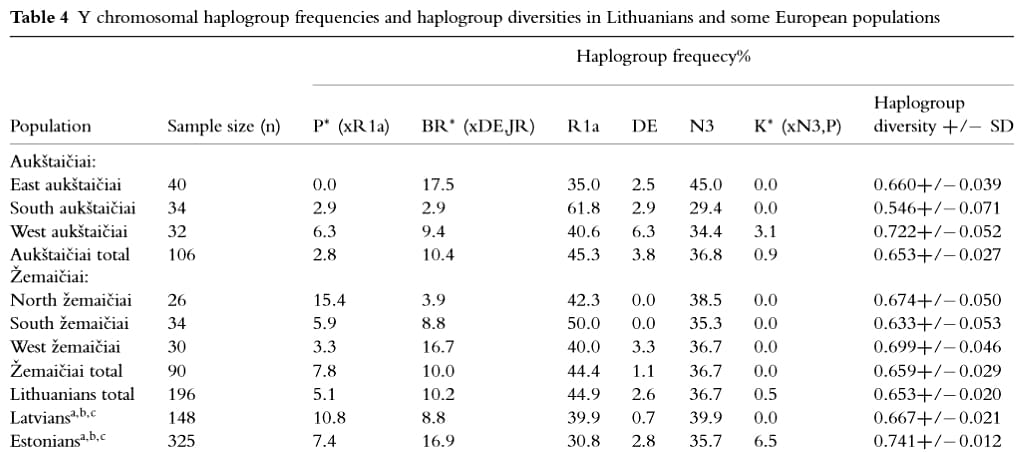IIRC Ken Nordtvedt and Vadim Verenich estimate the age of formation of I2a1b1 as 2800 years ago and its TMRCA as 2500 years ago. Place of formation was Eastern or East-Central Europe according to them. This young age combined with its presence among Slavic (especially East Slavic and South Slavic) populations and its lack of presence among Baltic populations, suggests that this mutation originally formed in one of members of the Proto-Slavic community around year 800 BCE. The time when the Balto-Slavic community split (an event illustrated by the graph below), forming Proto-Slavs and the other two groups (Proto East Balts and Proto West Balts - according to Kromer's 2003 theory) has been variously estimated at between 1500 BCE and 500 BCE, but most authors place it between 1400 and 1200 BCE:
Atkinson - 1400 BCE
Novotná & Blažek - 1400–1340 BCE
Sergei Starostin - 1210 BCE
Chang et. al. - 600 BCE
If this mutation is younger than the split of the Balto-Slavic community, then this fact nicely explains why I2a1b1 is present among Slavs but not among Balts. Had this lineage been present among Balto-Slavs before they split some 3400 - 3200 years ago, it should be present among both Balts and Slavs today (unless it was so small in numbers that - just by chance - only Slavs inherited it, and not Balts).
Now when it comes to R1a:
hrvat22 said:
The point is that Croats belong R1a Z280
This claim is completely wrong.
Data from Underhill 2014 shows that Croats have the highest proportion of M458 in entire R1a among South Slavs (read below).
Among Slavic and Baltic populations, when it comes to people with haplogroup R1a, two major clades dominate - Z280 and M458.
The age of these two clades is:
http://www.yfull.com/tree/R1a/
Z280:
Time when mutation emerged (in one male) - ca. 5000 years ago (95% probability that in period 5600 - 4400 y.a.).
Time of the most recent common ancestor - ca. 4800 years ago (95% probability that in period 5400 - 4200 y.a.).
M458:
Time when mutation emerged (in one male) - ca. 5000 lat temu (95% probability that in period 5600 - 4400 y.a.).
Time of the most recent common ancestor - ok. 4500 lat temu (95% probability that in period 5400 - 4200 y.a.).
=================================================
Distribution of percentage shares of these clades within all of R1a forms an interesting continuum (but also a clinal distribution in some areas).
If individuals with R1a haplogroup in each population = 100%, then respective shares of Z280 and M458 within that R1a are:
Population (R1a Z280 / R1a M458 / other clades of R1a) - according to Underhill 2014 (+ Ukrainians from Lviv & Lithuanians from another - Russian - source, as well as alternative data for Russians, Poles and Belarusians from the same Russian source):
WeS = Western Slavs
SoS = Southern Slavs
EaS = Eastern Slavs
Balt = Balts
[WeS] Czechs-----------------------------
(20,2 / 79,8 / 0,0)
[WeS] Czechs Utah------------------------
(19,9 / 70,0 / 10,1)
[SoS] Croatia interior-----------------------
(32,0 / 68,0 / 0,0)
[WeS] Poland------------------------------
(42,0 / 58,0 / 0,0)
[EaS] Ukrainians Cherkassy-----------------
(46,9 / 53,1 / 0,0)
[WeS] Poland (another source)--------------
(51,7 / 48,3 / 0,0)
[WeS] Slovakia-----------------------------
(52,1 / 46,2 / 1,7)
[WeS] Poles Wroclaw-----------------------
(56,8 / 43,2 / 0,0)
[SoS] Bulgaria------------------------------
(51,2 / 42,0 / 6,8)
[EaS] Ukrainians Lviv------------------------
(58,2 / 41,8 / 0,0)
[EaS] Ukrainians Ivano-Frankivsk-------------
(60,0 / 40,0 / 0,0)
[EaS] Belarusians Brest----------------------
(61,4 / 38,6 / 0,0)
[EaS] Russians Kostroma--------------------
(62,6 / 37,4 / 0,0)
[EaS] Ukrainians Donetsk--------------------
(67,4 / 30,4 / 2,2)
[EaS] Belarusians (another source)-----------
(69,7 / 30,3 / 0,0)
[SoS] Macedonians--------------------------
(72,7 / 27,3 / 0,0)
[EaS] Russians Pskov------------------------
(72,6 / 25,8 / 1,6)
[EaS] Russians Oryol-------------------------
(76,4 / 23,6 / 0,0)
[SoS] Serbia---------------------------------
(64,9 / 23,2 / 11,9)
[EaS] Belarusians (Underhill)------------------
(76,8 / 23,2 / 0,0)
[SoS] Bosnia--------------------------------
(80,2 / 19,8 / 0,0)
[EaS] Russians (another source)--------------
(80,8 / 19,2 / 0,0)
[EaS] Russians Belgorod----------------------
(81,2 / 18,8 / 0,0)
[Balt] Lithuanians----------------------------
(81,8 / 18,2 / 0,0)
[EaS] Ukrainians Khmilnyk---------------------
(84,3 / 15,7 / 0,0)
[EaS] Ukrainians Akkerman--------------------
(88,4 / 11,6 / 0,0)
[SoS] Slovenia-------------------------------
(83,9 / 10,7 / 5,4)
[SoS] Herzegovina----------------------------
(93,8 / 6,2 / 0,0)
Chart:
And graph:
http://s29.postimg.org/n8pi0uko7/Graph_Clades.png
=======================================
And here a map showing the percentage share of M458 among total R1a (based on data from Underhill, data from the other source not included):
Boundaries of frequency areas are approximate / conventional (since Underhill collected samples mostly from specific cities or groups of locations):











